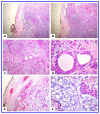Juvenile pleomorphic adenoma of the cheek: a case report and review of literature
- PMID: 19772659
- PMCID: PMC2759908
- DOI: 10.1186/1746-1596-4-32
Juvenile pleomorphic adenoma of the cheek: a case report and review of literature
Abstract
Pleomorphic adenoma, also called benign mixed tumor, is the most common tumor of the salivary glands. About 90% of these tumors occur in the parotid gland and 10% in the minor salivary glands. The most common sites of pleomorphic adenoma of the minor salivary glands are the palates followed by lips and cheeks. Other rare sites include the throat, floor of the mouth, tongue, tonsil, pharynx, retromolar area and nasal cavity. In children, intraoral pleomorphic adenomas of the cheek are extremely rare with only three cases reported to date. Here we report a case of pleomorphic adenoma of minor salivary glands of the cheek in a 17-year-old girl. The mass was removed by wide local excision with adequate margins, and after a follow-up period of three years there were no recurrences. To conclude, pleomorphic adenoma should be considered in the differential diagnosis of cheek masses in youngsters. Wide local excision is to be recommended as the treatment of choice. A close follow-up is necessary postoperatively.
Figures


References
-
- Garcia Berrocal JR, Ramirez Camacho R, Trinidad A, Salas C. Mixed tumor (pleomorphic adenoma) of head and neck. Typical and atypical patterns. An Otorrinolaringol Ibero Am. 2000;27:333–40. - PubMed
LinkOut - more resources
Full Text Sources

